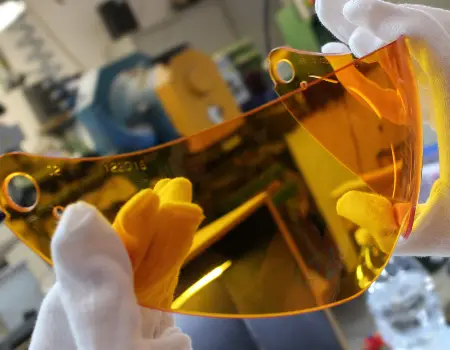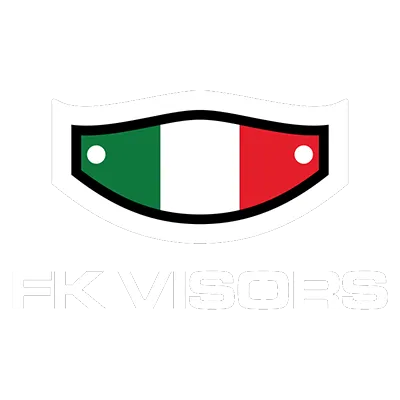
The Art of Motorcycle Helmet Visor Manufacturing: Advanced Technologies & Safety
Indice dei contenuti
The production of motorbike helmet visors has evolved significantly over the years, thanks to advances in materials and technological innovations that have improved the safety and performance of helmets.
Evolution of Materials: From Plastic to High Resistance Polycarbonate
In years past, motorbike helmet visors were often made of simple plastic materials that offered basic protection. However, as technology has advanced, there has been a shift towards high-strength polycarbonate. This material is known for its ability to withstand shocks and impact forces, offering a higher level of protection than traditional plastics. In fact, polycarbonate is lightweight yet extremely strong, providing reliable protection even in the most extreme conditions.
Ergonomic Design: Optimising Protection
A key aspect in the production of motorbike helmet visors is ergonomic design. The shapes and curves of the visor not only enhance the aesthetics of the helmet, but also play a crucial role in optimising protection and visibility for the motorcyclist. An ergonomic design allows for a better distribution of impacts during a crash and reduces visual distortions, offering clear vision and greater comfort to the rider.
Production Processes: Cutting, Moulding and Quality Control
The production of motorbike helmet visors requires cutting, moulding and quality control processes, using high-precision machine tools.
- Cutting is performed with the aid of dies or CNC machines (CNC machines are tools that perform movements guided by an integrated electronic device known as a numerical control. Their movements and functions are predetermined and programmed in advance using specialised software). CNC cutting, in particular, guarantees clean and uniform edges, avoiding any risk of imperfections that could compromise safety.
- During the moulding phase, the polycarbonate is moulded with extreme precision to obtain the desired profile of the visor, ensuring a perfect fit on the helmet.
- Finally, quality control is essential to check the strength and transparency of the visor, ensuring that it meets the high safety standards required.
Antiscratch and Antifog Innovations: Improvements for Visibility and Safety
Innovations in antiscratch and antifog have transformed the motorbike helmet riding experience.
- Antiscratch coatings, in particular, reduce unwanted reflections and preserve the visor finish in the long term.
- Anti-fog treatments, on the other hand, prevent the formation of condensation inside the visor, ensuring clear vision even in high humidity conditions.
These crucial technologies contribute significantly to the safety of the motorcyclist, enabling a more conscious and safer ride.
The Advantages of Polycarbonates
Due to their lightness and strength, polycarbonates offer a number of advantages that make them ideal for motorbike helmet visors. Their impact and breakage resistance ensures reliable protection, while their crystal-clear transparency allows a clear, distortion-free view while riding.
Importance of Ergonomic Design
Ergonomic design is not just a matter of aesthetics; it plays a crucial role in rider safety and comfort. Carefully designed visors offer an optimal fit, distributing impacts evenly and minimising visual distortions, thus improving the overall quality of the riding experience.
Speaking of visor design, we note that there are two types:
- Flat or flat visors, which are applied in sport or racing helmets or track helmets; the flat visor, in fact, offers the possibility of tear off (tear offs are plastic strips that are applied to the visor of the riders’ helmet. During a race or practice session, the visors can get dirty, allowing riders to remove the strip to restore clear vision and have a new tear off ready to use).
- Domed visors are used in custom helmets or for purely commercial purposes. In this case, aesthetic beauty and customisation are put before functionality
Ensuring Safety in Production Processes
The production processes of motorbike helmet visors are subject to strict quality controls to ensure maximum safety. Every stage, from moulding to finishing, is carefully monitored to ensure that each visor meets the high standards required by the industry. The materials used are tested to withstand stress and strain, ensuring reliable performance even under the most demanding conditions.
Positive Effects on Helmet Performance
High-quality visors not only contribute to safety, but also have a positive impact on overall helmet performance. Ergonomic design and advanced production materials can improve aerodynamics and reduce wind noise and external influences, providing a more comfortable and significantly more enjoyable riding experience.
Motorbike Helmet Visors: Performance and Protection for All Riders
In conclusion, we can say that the art of motorbike helmet visor production today incorporates cutting-edge technology and innovative design principles to ensure maximum safety and comfort for riders.
From the evolution of materials to the precision of manufacturing processes, every aspect is designed to enhance the riding experience and protect the life of anyone wearing a helmet.

